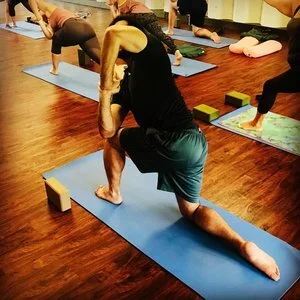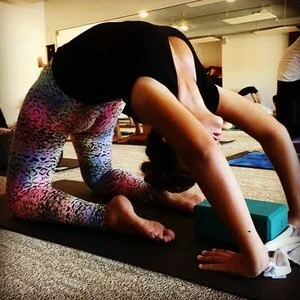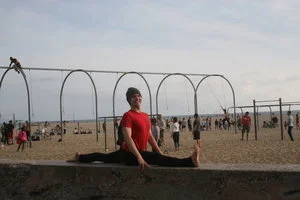Grateful for these wonderful students who came to practice with me. Thank you ToYoga for organizing this great class. We couldn’t fit even one more in. It was a yoga feast!!!
I’ve been back in Qingdao this week!
I’ve been back in Qingdao this week! Really fun group of students came to take 2 Shiva Power Master Classes with me. A hip opening and shoulder opening class on Wednesday night and a deep twisting and core strength class on Thursday night. Thank you to everyone who came out to practice. It was nice to see you all and practice with some of you again. Looking forward to next year!!! I think we are going to plan a longer training program if I can fit it into my schedule. Thank you to my student, Faye who graduated my Shiva Yoga 200hr RYT Teacher Training Program 2 years ago for organizing these classes. And thank you to Belle for translating. It’s been a long time my friend. Have missed you. Namaste
Hot and sweaty Shiva Power class!
A hot and sweaty Shiva Power class at Float Yoga!
A hot and sweaty Shiva Power class at Float Yoga! Thank you, Stella for inviting me to teach at your studio. It was a really humid day and, WOW, did we go into the fire!!! Strong students!!! Great job, everyone. It was fun practicing with all of you. I’m looking forward to seeing you all again soon.
Shoulder Opening Workshop at Dream Space Yoga.
Learning about the shoulders in my shoulder opening workshop at Dream Space Yoga this past week. Shiva Yoga Intensive. Backbends are the primary poses in our yoga practice that we use to open the shoulders. We are usually focused on opening the shoulders in extension or flexion, in order to increase our range of motion. If we have full range of motion at the shoulder join we can prevent injuries to the neck and upper back. If you want to be able to do more advanced backbends in your yoga practice it is essential that you open your shoulders.
Yoga is constantly asking you to look at the truth.
Shoulder Opening Workshop today at Haipoo Yoga!
We mostly work in our yoga practice on opening the shoulders in Flexion and in Extension. Having a full range of motion at the shoulder joint helps to prevent injuries to the cervical spine and helps release tension in the muscles of the upper back and around the neck. Most of our shoulder opening poses in yoga are backbends. Usually the more advanced backbends take the shoulders into flexion but not always. It’s important to also remember that yoga is not just about flexibility. We are always looking for balance. Too much flexibility can lead to injuries at the joints. Not enough flexibility can lead to injuries in the muscles. This picture is of one of my favorite shoulder opening partner exercises. In this position, you can help your partner take their shoulders deeper into flexion, you can use your hands to help them externally rotate their shoulders, and you can encourage them to find more core and pull their front ribs in making more space and lengthening their spine. When you engage your core while Backbending you lengthen your spine and you actually deepen the pose
4 Main reasons for doing Sun Salutations.
I taught a big Sun Salutation practice this morning at the Zhejiang Yoga Cultural Festival. Good attendance! It was very early in the morning and a little cold. But we persevered.
Sun Salutations have been practiced by yogis for thousands of years. When we practice them we are walking in the footsteps of our teachers and their teachers.
The "Tug of War" Practice
A week ago we wrapped up an incredible Shiva Yoga 50hr Intensive at Baja Soul Yoga in Cabo San Lucas! Here’s a few pics from our Backbending Workshop on the last day of the intensive.
It is so important to understand the relationship between the core muscles, and the spinal erectors and the other muscles that take the spine into extension when you are Backbending. One of my teachers used to say that in every backbend there is a little forward fold. When you engage your core while you are Backbending, your backbend actually gets bigger. You create more space. Your spine lengthens. You don’t put so much pressure on your lower back. And you get to stretch your hip flexors. It’s this relationship of opposites and finding the balance between them that can really take us deeper into the practice. Some teachers call these actions and counter actions. I call this the ‘tug of war’ principle. It is the dance that is happening between the agonist and the antagonist muscles all the time. Sometimes there is an equal fight, sometimes one side wins, but the other side doesn’t just drop the rope and give up. The antagonist is still fighting, just like the villain at the end of the movie, who rarely throws in the towel and goes quietly away.
Fun Shiva Power class this morning at Baja Soul Yoga!
Yoga philosophy teaches us that yoga is the stopping of the movements of the fluctuating mind. When the mind is quiet — in stillness, we experience the true nature of our Self. When the mind is constantly moving and distracting us, we never really get to see who we are because we are caught up in all the movements, and all the distractions. It’s like things are upside down. The senses are leading the mind, and the mind is dragging us along for the ride. Yoga is the practice of taking charge again. You are directing your mind to control your senses, and focus on the things you want to focus on. Every time you concentrate on something and hold your focus — you increase your willpower. Every time your mind wanders off and fidgets, distracting you — the pattern of distraction gets stronger. The greatest battle you will ever fight is the one with your mind. Concentrate! Without concentration there is no yoga
My Nana and her grandkids!
Control Your Breath, Control Your Mind.
The breath is so important in a physical yoga practice. The yogis say, “if you can control your breath, you can control your mind.” Breathe deeply. Breathe down into the belly. This is called diaphragmatic breathing. Breathe into the side ribs. This is called costal breathing. Yogic breathing is often described as a combination of these two types of breathing. You want your breath to be long and slow. But you don’t want to fill the lungs so much that the collar bones lift and the upper chest lifts up towards the neck. This is called clavicular breathing. It is not recommended during your yoga practice. It stimulates the nervous system and is usually only used when the body is starving for oxygen. Breathe in and out through the nose. Let the breath lead you into the movement in your practice. Let the body follow the breath. Krishnamacharya says, “Let the breath be the Guru and the body be the disciple.” Ujjayi pranayama is very balancing. It can be performed in any asana. The Ujjayi pranayama is used to control the breath and slow it down. We can’t control the breath at the nostrils without using our fingers. But we can control the breath by constructing the throat muscles, as if we are sipping the breath through a tiny straw.
Congratulations, Arisa!
Taking a moment to honor my student, and recent graduate of my Shiva Yoga 200hr Teacher Training program, Arisa Takasaki. Arisa is the first person to finish the post training required assignments, after completing training in August in Cabo San Lucas. She just recently joined Yoga Alliance as a registered yoga teacher at the 200hr Level. Congratulations, Arisa!
Hatha Yoga
Hot and sweaty twisting themed Shiva Power® class! We are exploring a lot of cleansing, mudra, bandha, and pranayama this week in my Shiva Yoga 200hr Teacher Training program.
Hatha Yoga uses the physical body and the energetic body to move beyond the mind and ego and experience the Ultimate Reality. Tantra philosophy tells us the Universe is a balance of masculine and feminine. When you find perfect balance in yourself you get to experience the Ultimate Reality! Before you practice mudra, bandha, and pranayama — first use the cleansing practices and asana to purify the physical body. Remove excess mucous (kapha) from the respiratory system, remove excess wind (vata) from the digestive tract, and stoke the digestive fire (pitta) to help remove excess body fat and prevent digestive problems. Awaken the subtle sense perception with Trataka. When the body is ready — use mudra, bandha, and pranayama to bring the masculine and feminine energy together, unite the opposite upward and downward forces, and balance the nervous system.
Happy 4th of July!
Happy 4th of July! I chose to move here almost 15 yrs ago. Love it. Love California. Love the ocean. Love the people. No regrets.
The world right now is going through a major awakening -- and that is always messy. I think something wonderful is going to come out of the many challenges we see around us.

















